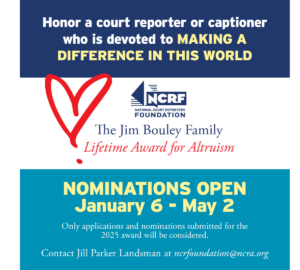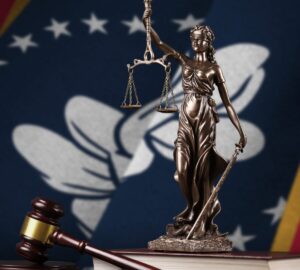By Sheryl Teslow and Lori McGowan
Lori McGowan, center left, and Sheryl Teslow, center right, write the public’s comments on the Keystone pipeline. Photo courtesy Omaha World-Herald.In 2013, the U.S. State Department held a public comment hearing in Grand Island, Neb., as part of the presidential permit application. The pipeline is designed to carry tar-sands oil from Alberta, Canada, to the Gulf Coast for refinery and export. Because it crosses the border with Canada, the presidential permit is required.
Latimer Reporting was hired to report the day-long hearing. Lori and I took on the assignment ourselves. We knew it would go all day and into the night, so we knew we wanted two reporters. At first, we thought one would do the first half and the other would cover the second half. At the last minute, we decided to ride out together, so we were both there from the beginning. That turned out to be incredibly helpful. I took the first section of testimony. The first few witnesses were Native Americans who spoke in both Lakota and English, using many unfamiliar names of people and places. When the first speaker finished, Lori had the presence of mind to approach him before he sat back down and asked for the notes he was reading from. We continued that practice throughout the entire hearing. We were not always able to convince the speakers to turn over their notes, but most of them did cooperate. The hearing began at noon and ended at 11 p.m. The transcript was 494 pages.
The pipeline and its route are highly controversial and in 2015, President Barack Obama denied the permit. In 2017, President Donald Trump revived the project, and the responsibility for siting the pipeline through Nebraska now rests with the Nebraska Public Service Commission. They scheduled a public comment meeting to be held in York. Latimer Reporting, and Lori in particular, has a great deal of experience with the Public Service Commission, so they asked us to cover this hearing. The hearing began at 9 a.m. and ended at 7 p.m. The transcript was 406 pages.
Since Lori and I had the experience in 2013, we, of course, took on the assignment again and used the same process. One of us would write the proceedings and the other would track down speakers as they finished and request their notes, and then we would switch off.
As far as preparation, we really didn’t do that much to prepare for the first hearing in 2013. We were familiar with the issue and some of the interested groups. We did do a little bit of internet searching for some possible technical terms that might come up, but there wasn’t much we could do to prepare. There was no list of witnesses and no appearances of counsel. Most of the speakers were concerned citizens and landowners, so there wasn’t a great deal of technical testimony.
The same things were true in 2017. We arrived at the venue two hours ahead of the scheduled start time and made sure that the sound system was in good working order and that we were directly in front of the speaker podiums. We had our job dictionaries from the first hearing and were now more familiar with the names of people and places and technical terms that were likely to come up.
The 2013 transcript was used by the State Department. We were told it would eventually end up on President Obama’s desk and was part of the official record used to deny the pipeline permit. The 2017 transcript will become part of the official record of the Nebraska Public Service Commission in their decision on siting.
Public comment hearings do present some interesting challenges. Speakers are given five minutes to present their testimony. Very few of them are used to public speaking. They are speaking to a very large crowd and in front of many television news cameras, so they are nervous and tend to read from their notes very quickly. The large crowd behind them at times reacts loudly, sometimes in support and sometimes in opposition to what they are saying, sometimes to the point of drowning the speaker out. There are speakers who cry and speakers who are angry and speakers who yell, so it can be a challenge sometimes to hear them. Again, most people were cooperative in turning their notes over to us when we explained it would help us prepare the transcript. When they were reluctant, we offered to give them an envelope and promised to return the original to them. Some speakers would let us take a photo with a phone.
Each speaker was required to register and received a number. They filled out a sheet with their name, place of residence, speaker number, and whether they were speaking in support or in opposition. Speakers were called up to the microphone in order. They had five minutes to speak. They were instructed to leave those sheets with us at the end of their time. So when we retrieved the notes they had read from, it was easy to keep the notes with the sign-in sheet and the speaker number.
Quite honestly, at the end of the hearing in 2013, Lori and I looked at each other and said, “Never again.” The experience was stressful and draining and a bit out of our comfort zone. But as is usually true, an experience that challenges you is rewarding in the end, and it was interesting and fun to be in the middle of history. So naturally, when our client asked us to do it again, we took a deep breath and said yes.
Sheryl Teslow, RDR, CRR, and Lori McGowan, RDR, CRR, are both owners of Latimer Reporting in Lincoln, Neb.






